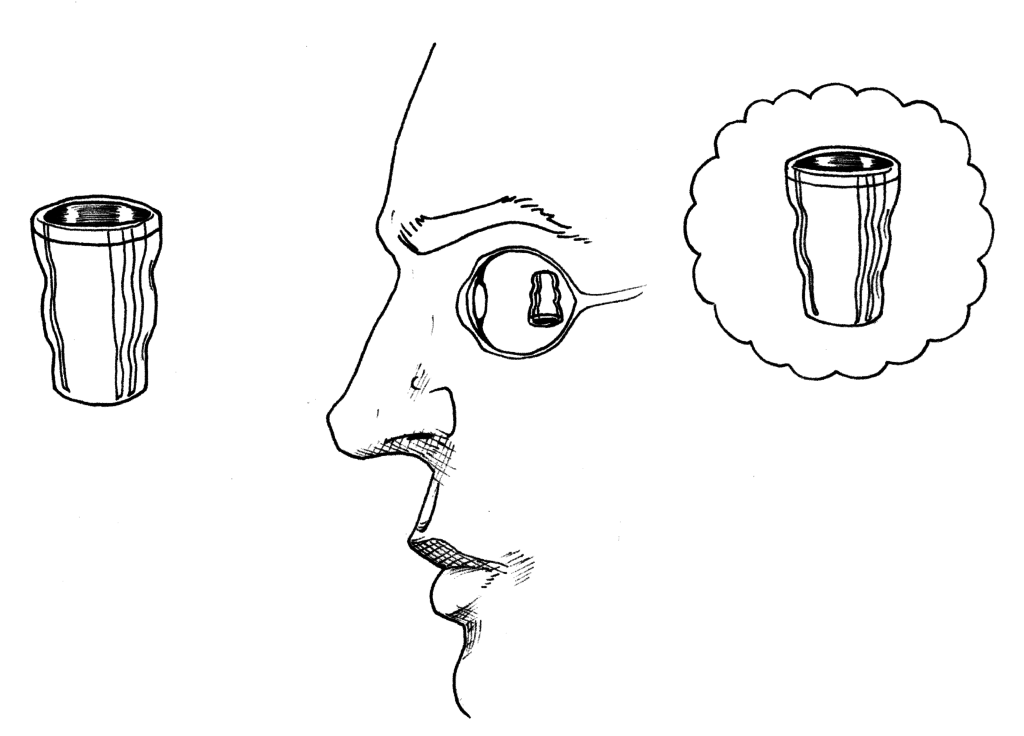Reading my two previous posts, you might complain that perceiving and remembering require concepts, ideas, or even thoughts, which are basically representations, and plants don’t have those, so they don’t perceive or remember. For the same reason, you might add, they don’t have minds.
Do plants have representations?
Phototropism can seem to involve representation. The sun itself does not arrive at the plant, but exerts itself on the plant by electromagnetic radiation, which makes an initial impact on some part of the plant, the photoreceptors, specialized parts of cells that are distinctively sensitive to light. These initial effects are arguably representations of the sun; not just an effect of the sun, but a sign of the sun. They are, one might say, more or less, like the images formed on the lens of our eyes when we see something. Although we see no image on the surface of a plant when it is being affected by the sun, there is nevertheless something comparable going on—even if it is harder to detect, or not easily seen.

That way of thinking relies on one important theory of what a representation is, of what it is for one thing—such as an image or word—to represent another. Very roughly, the idea is that if X causes Y, then Y represents X. For example, smoke represents fire, because it is caused by fire; wet pavement caused by rain represents rain; a deer’s hoof print represents a deer.

Many theorists of representation reject this sort of theory, for it implies that too many things represent. For instance, a patch of earth thawing on a winter day is a representation, of the rising ambient temperature. More generally, on this theory, anything with a cause—including specks of dust—is a representation. But, surely, not every speck of dust is a representation! Pictures and statements are paradigms of representation, each capable of portraying something as being some way or other. A picture of a daffodil portrays it as being some way or other. The statement ‘That daffodil is handsome’ portrays some daffodil as handsome. A random speck of dust does not portray it cause or anything else in any way. So, many theorists think that causation does not suffice for representation.
On another influential theory of representation, one thing X represents another thing Y if X’s job or function is to be an effect of Y. For instance, a ringing doorbell represents a pushing of the button because the bell’s job is to ring in response to a pushing of the button. Normally, the ringing is caused by exactly that, but even when it is caused by something else—a short circuit, for instance—the ringing still represents the button as having been pushed. In that case, the ringing bell misrepresents the button as having been pushed.
This theory supports the claim that plants represent. Stimulation of Venus’s trigger hairs represent the presence of an object on its lobe, not simply because that object affects them, but rather because it’s their job to be so affected. Activated states of photoreceptors represent light, because it’s their job to be so affected.
This sort of theory is ingenious, but many smart theorists think it is still wrong, and for the same of reason that the other theory is wrong. Too many things wind up counting as representations. On your average sink, the valve’s job is to open when the knob is turned. But the open valve does not represent a turned knob. In itself, it represents nothing—though, say, a plumber might use an open valve as evidence of a turned knob.
So, although there may be some initially plausible reason to think that plants have representations, the theories of representation that support thinking they do are widely thought to be inadequate.
Still, that fact by itself does not show that plants don’t have representations. You might still hope that an adequate theory of representation will come along, and it will support thinking plants have representations.
Here is a good reason to remain doubtful. In explaining and understanding plant behaviors, botanists appear not to have any great need to posit that plants represent the environment external to themselves. Doing so does not provide any significant explanatory gain.
Consider gravitropism in roots. The bits sensitive to gravity, generically called “statoliths,” are amyoplasts, subcellular bodies that sediment at the bottom of special cells, statocytes, in the tips of roots. The amyoplasts are somewhat denser than the rest of the cell, and will accordingly drift to the bottom of the cell. They’re like rocks in a jug of water; turn the jug, and the rocks will drift to the bottom. When the amyoplasts settle on the bottom of the cell, auxin is transmitted to one but not another side of the root, causing differential growth. Here it might be tempting to say that roots grow down because the statoliths represent where down is. As metaphor or shorthand, that way of talking may be fine. But it doesn’t make root growth easier to understand. It does not allow us to understand something that we could not otherwise understand. We can instead say that the root grows that way because the statoliths moved in that direction, which stimulated the production of auxin, and its transmission to one side of the root, causing cells there to expand.
Then again, maybe plants have minds even if they don’t have representations.


Hi Chauncey — how about the behavior (?) you discussed in your last post, where a plant that tracks the sun then returns overnight to where the sun will be in the morning? Is it helpful to understand this in representational terms? The paper by Francisco Calvo Garzon that you cite in there certainly does so: https://www.tandfonline.com/doi/full/10.4161/psb.2.4.4470
Thanks, John. I agree that it is tempting to understand that behavior in representational terms. However, while that behavior is influenced by elements internal to the leaves as well as the sun’s previous position, I don’t think much or anything is gained by holding that those internal elements *say* (as a sentence would) or *depict* (as a picture would) the likely future location of the sun, and then control leaf behavior. Instead, I think the behavior can be understood adequately in terms of a series of (complex!) feedback loops between the leaves and the environment.
Hi Chauncey and thanks a lot for these wonderful posts!
As a short comment: I just think whether it would be useful to approach plant cognition from more enactivist perspective rather than from representationalist theories. Within enactivism, cognition is understood in terms of sense-making (based on autonomous organization of the living system) rather than in terms of representations. So, it would be interesting to consider whether the notion of sense-making is applicable to behavior of plants. Maybe one critical question would be the requirement of sensorimotor behavior as a mark of (enactivist) cognition and whether plants could be seen as sensorimotor “agents”.
Chauncey’s last line here made me suspect that this is just where things are going …
Yep!
I don’t think these sorts of bewitchments by grammar (analogy, etc) are going to bear out in terms of the relevant (or lack of) physiology allowing for an enactivist approach, would take something more radical like autopoiesis
“Thus, plants that track the sun with their leaves
needn’t represent it or its position, because the tracking can be guided
directly by the sun itself. But if the relevant features are not always
present (manifest), then they can, at least in some cases, be represented;
that is, something else can stand in for them, with the power
to guide behavior in their stead. That which stands in for something
else in this way is a representation; that which it stands in for is its
content; and its standing in for that content is representing it.” John Haugeland, Representational
Genera.
Thanks, James. I admire John Haugeland’s work in general, and that essay in particular. How do you interpret this particular remark? I think he is primarily raising the issue of how representations can be involved in behavior. I don’t think he’s endorsing the idea that plants do indeed represent, for I don’t think he thinks mere “standing in for” suffices for representation, of that sort that interest him in that essay.
I found this quote a while ago ready Andy Clark. I think Clark uses it to accommodate certain anti-representationalist sentiments: no need to represent something that you are immediately perceiving and interacting with. Clark seems to think that “absences” of things or events is a good place to start regarding the need for (internally generated) “representations; linked to action (coping with the environment). Perhaps to the extent that plants have a central nervous system, there might be some possibility that enjoy something resembling “cognition involving content/representation”. One would think a central nervous system would be an anatomical prerequisite for such a capacity (?). Also, “action oriented” thoughts would probably be wasted on a species that doesn’t seem to have very much of a diverse behavioral repertoire (not compared to we humans).